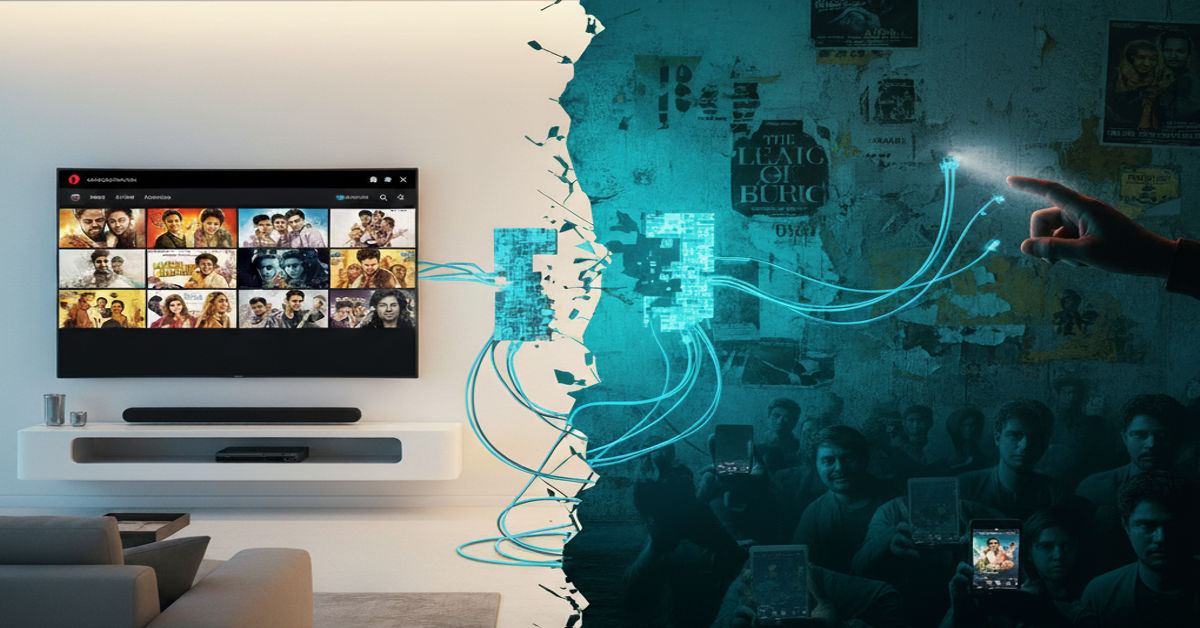Type a popular Bollywood title into a search engine on the day of its release, and chances are high that one of the suggested results includes the phrase “Hdhub4u Bollywood.” For many Indians, especially younger, mobile-first viewers, the term signifies a familiar but legally fraught corner of the internet — an ecosystem of piracy portals offering unauthorized access to newly released films, television shows and streaming originals. The sites are not glamorous, and they are certainly not safe, but they remain persistent fixtures of the digital landscape.
The search intent behind that phrase is straightforward: people want free, fast, and easily accessible entertainment. But the context surrounding it is anything but simple. Piracy platforms like hdhub4u bollywood sit within a larger, evolving conversation about affordability, digital rights, cybersecurity, and the economic pressures shaping India’s rapidly expanding media industry. Even when authorities block one domain, the ecosystem regenerates through mirror sites and proxy links that appear almost instantly, reflecting the resilience of a shadow market that thrives on demand.
To understand why these platforms endure — and what they reveal about the future of entertainment in India — it is necessary to look beyond simplistic notions of lawbreaking. This is a story about pricing tensions in the streaming economy, gaps in legal accessibility, deeply rooted viewing habits, and the cat-and-mouse strategies that define digital enforcement. It is also about risks that are far less visible: malware-laden advertisements, data theft, and criminal networks that exploit the language of free entertainment.
This article unpacks the layers of that story. Through expert insights, on-the-ground observations, and economic and cultural analysis, it examines how one piracy hub symbolizes a broader struggle to make digital entertainment both affordable and secure in a country of more than a billion viewers.
The Quiet Architecture of Digital Piracy
Behind the cluttered appearance of piracy portals lies a surprisingly durable infrastructure. Sites like those associated with “hdhub4u bollywood” do not rely on a single server or hosting provider. Instead, they distribute content across multiple file-sharing hosts, temporary cloud storage locations, and mirror domains designed to reappear faster than authorities can block them. Operators often use anonymizing tools and rapidly changing URL structures, allowing each version of the site to survive only as long as necessary before shifting elsewhere.
This approach creates a hydra-like network — diffuse, adaptable, and inexpensive to operate. Even when enforcement agencies successfully take down a domain, a duplicate emerges almost immediately, sustained through advertising revenue from risky pop-ups and redirects. Ironically, it is this low overhead, not high-end technology, that fortifies the ecosystem. Small clusters of operators can maintain a platform that attracts millions of visits monthly, despite constant pressure from regulators.
Economic Ripples in the Film Industry
India’s film sector, one of the largest in the world, feels the impact of piracy in uneven but tangible ways. Theatrical releases — especially action blockbusters and festival-season films — depend heavily on early box-office momentum. When unauthorized copies appear online within hours of a premiere, the effect can be immediate: reduced footfall, shrinking weekend collections, and downward pressure on distribution fees.
Producers of mid-budget and independent cinema experience different challenges. Some say the exposure boosts discussion around their work, but none deny the financial consequences. As Prof. Kavita Menon, a media law scholar, notes, “Visibility without revenue cannot sustain creative industries. Piracy disrupts the equation on which film production relies: investment, circulation, and return.”
Streaming platforms feel the effects as well. When pirated versions surface before the digital release window, negotiations for licensing fees become complicated. Over time, this undermines confidence in India’s content economy, making investors cautious.
Why Users Continue to Choose Piracy
While affordability is a factor, user behavior reveals deeper motivations. For decades, India’s informal entertainment culture relied on cable replays, bootleg DVDs, and neighborhood sharing. This normalized the idea that content circulates freely. Today, digital piracy extends that legacy into the age of smartphones.
Behavioral economist Dr. Suresh Mandal explains: “Users often pick the path that requires the least effort. If legal content requires juggling apps or subscriptions, and illegal content is one click away, many will choose ease over legality.”
Regional disparities also play a role. Films available legally in one state may be missing in another due to linguistic licensing issues. Piracy offers a workaround — albeit an illegal one. Additionally, spotty broadband in rural areas pushes users toward downloaded files rather than live streaming. For many, convenience, not malice, drives the decision.
Comparing Piracy Portals With Legal Streaming Services
| Feature | Piracy Portals (e.g., those resembling hdhub4u bollywood) | Legal Streaming Services |
| Legality | Unauthorized, illegal | Licensed, regulated |
| Cost | Free, ad-supported | Subscription or ad-tiered |
| Safety | High exposure to malware | Secure, compliant |
| Content Variety | Unrestricted, often leaked | Curated, rights-based |
| Reliability | Inconsistent quality | Stable high-resolution delivery |
The Limits of Regulation
India has steadily expanded its anti-piracy rules, from penalties for unauthorized recording in theaters to dynamic court injunctions allowing rights holders to request instant blocks on new mirror domains. Yet enforcement alone struggles to keep pace with the speed of domain replication. When one site vanishes, clones surface through minor URL adjustments or new hosting locations.
Cyberlaw specialist Rohit Nigam explains the challenge: “Piracy networks operate across borders. Servers might be in one country, administrators in another, and ad partners spread across several regions. No single domestic authority can act effectively without cooperation from multiple jurisdictions.”
Blocking also addresses only supply, not demand. If legal access remains fragmented or costly, users continue seeking unauthorized alternatives. Policymakers increasingly view piracy not as a purely legal problem but as a market problem requiring coordinated reforms across telecoms, streaming providers, and financial intermediaries.
Timeline of Key Anti-Piracy Measures in India
| Year | Measure Introduced | Intended Effect |
| 2010 | Early ISP blocking orders | Temporary access restrictions |
| 2016 | Government cybersecurity advisories | Public education on risks |
| 2019 | Cinematograph Act update | Stronger penalties for camcording |
| 2021 | Wider adoption of dynamic injunctions | Faster domain takedowns |
| 2024–25 | Industry exploration of bundled streaming | Reduce demand for piracy |
Threats Beneath the Surface
The most understated danger in using piracy portals is cybersecurity. Visitors often confront pop-ups disguised as download buttons, redirects to unfamiliar websites, and unverified files claiming to be video players. These are not harmless inconveniences. Many contain malicious code capable of logging keystrokes, lifting browsing data, or installing trojans.
Cybersecurity analyst Priya Mathur observes, “People assume they’re risking only legal repercussions, but the actual threat is data compromise. Once malicious software enters a device, it can be used for fraud, identity theft, or even as part of larger cyberattacks.”
Some piracy networks also distribute adware that bombards users with intrusive advertising or hijacks browser settings. Because many users access these sites on shared family devices, the risks ripple beyond individual viewers. For cybercriminals, piracy portals offer the ideal bait: something millions want, offered for free.
The Future — Market Reform and Consumer Behavior
India’s streaming industry is now experimenting with solutions aimed at reducing piracy’s appeal. Some platforms have begun exploring cable-style bundled packages, offering a group of services at a unified price. Others are adding low-cost ad-supported tiers to accommodate price-sensitive households. Improvements in regional content availability and multilingual interfaces have helped expand legal adoption, but inconsistencies remain.
Filmmakers are also rethinking release strategies. Coordinated theatrical and digital premieres shorten the window during which piracy causes the most damage. Technological updates such as enhanced watermarking and tracking systems help identify leak sources earlier.
Long-term progress depends on aligning convenience with legality. When legal routes are easy, affordable, and consolidated, piracy loses its competitive advantage. Until then, unauthorized platforms will continue exploiting the gaps that remain between viewer demand and industry structure.
Key Takeaways (5–7 bullets)
- Piracy persists because it offers simplicity and convenience where legal options are fragmented.
- Sites resembling hdhub4u bollywood expose users to hidden cybersecurity threats, including malware and data theft.
- Bollywood’s financial ecosystem — from theatrical revenue to digital licensing — is significantly affected by unauthorized distribution.
- Enforcement alone cannot solve piracy; improved pricing, bundling, and accessibility are essential.
- Market reforms and increased media literacy are key to reducing reliance on illegal platforms.
- Streamlined streaming packages and coordinated release strategies show promise for long-term impact.
Conclusion
The phenomenon often represented by the search term “hdhub4u bollywood” is not merely a story about a single website. It is an entry point into a deeper conversation about how India watches, values, and protects entertainment in the digital age. Piracy sits at the junction of economic pressure, technological agility, cultural habits, and regulatory constraint. It thrives where convenience outweighs caution and where legal options fail to meet public expectations.
Yet the landscape is shifting. As streaming companies reconsider pricing models, as regulators refine strategies, and as audiences become more aware of cybersecurity risks, the foundations of the piracy ecosystem face increasing pressure. Still, eliminating unauthorized platforms Hdhub4u Bollywood completely will require more than blocking domains. It demands a broader recalibration — one that recognizes entertainment as both a cultural right and an economic product.
The ultimate challenge is creating a digital environment where legal access is not only the ethical choice but the easiest one. Until then, the shadow circuit of piracy will continue reflecting the gaps left behind by the systems meant to replace it.
FAQs
1. Is accessing piracy sites legal?
No. Sites that distribute copyrighted content without permission violate intellectual property laws. Accessing or downloading from them may pose legal and cybersecurity risks.
2. Why do these sites keep returning after being blocked?
Operators use techniques like domain hopping, mirror sites, and offshore hosting to reappear within hours of a takedown.
3. How does piracy affect the film industry?
It reduces theatrical revenue, complicates streaming agreements, and undermines long-term investment in new films.
4. Do piracy portals contain malware?
Often yes. Many include malicious scripts, deceptive ads, and spyware that can compromise personal data or harm devices.
5. What are safe alternatives for watching Bollywood films?
Licensed platforms such as Prime Video, Netflix, Disney+ Hotstar, ZEE5 and others offer authorized, secure access.







